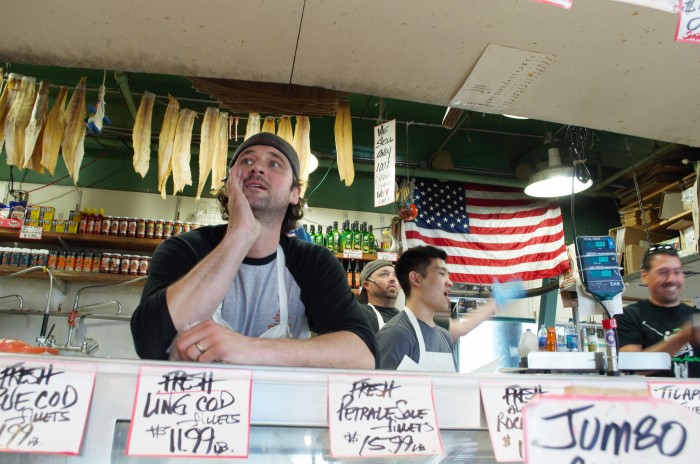It’s a late Spring afternoon at Pike Place Market, and crowds are gathering around Seattle’s world famous seafood hub, cameras in hand, to witness the iconic fish toss.
A customer approaches a fishmonger and places an order.
“King salmon fillet!” the fishmonger shouts to the other workers.
“KING SALMON FILLET!” they bellow back in unison, and in a matter of seconds, the fish is sent flying over the crowd and into the arms of one of the workers to be weighed for sale.
This is how seafood is sold at Pike Place Fish Market in Seattle. It’s loud. It’s boisterous. And it’s sustainable.
That’s in stark contrast to most of the imported seafood you’ll find in your grocery store’s frozen food section — especially if it’s marked “Product of Thailand.”
Reports warn of an epidemic of migrant workers being trafficked to work in Thailand’s seafood industry — one of the largest in the world. The workers come from neighboring countries like Cambodia and Myanmar, and are forced to work in factories and onboard ships.
“Originally, [the workers are] trying to get a better job; they’re trying to move to Thailand so they can work and make money and send it home,” said Josh Stride a campaigner from the Environmental Justice Foundation (EJF).
The EJF is an organization from the UK that focuses on the intersection of human rights and environmental issues. Stride, who monitors the world’s shrimp fisheries within the organization, said they began a two-year investigation in 2012 that revealed major human trafficking issues on the ships and factories of the seafood industry in Thailand.
“Someone had lied to them, telling them that they were going to get a job in a furniture factory or in a pineapple factory — something like that,” Stride said. “And, by the time they got to the end of their journey, they found themselves at a port and were forced onto a boat.”
A short documentary produced by EJF outlines trafficking in the Thai seafood industry.
Often the workers are forced to work off a debt in order to be taken back to Myanmar or Cambodia, but the amount only increases as they work.
“Suddenly, they start being charged for food, suddenly they start being charged for equipment, and they find it nearly impossible to pay off that debt,” Stride said. “Which means they’re basically stuck there.”
EJF estimates that about 90 percent of the workers on Thailand fishing ships are migrant workers from Cambodia or Myanmar, and that a large number of those workers have been trafficked.
As of 2012, Thailand was the second largest exporter of seafood to the U.S. The most common exports are shrimp, tuna, and sardines.
You don’t have to look far to find Thai seafood within reach. In the frozen food section of almost any local grocery store, you can pull a bag or box of frozen shrimp out of the freezer, and find the words “Product of Thailand.”.
“It’s very difficult to link a product on a shelf back to an abusive boat or back to an abusive factory,” he said. “We can say with relative amount of confidence that if you are importing seafood from Thailand, somewhere along the line, there has been some abuse in your supply chain.”
Stride said big grocery store companies only inspect the major supplying company they buy the food from, not the previous links on that chain.
“It’s very easy for big companies and retailers to either claim ignorance or wash their hands of certain parts of the problem,” he said. “There’s a tendency for everyone to want to pass the buck to somebody else.”
Anders Miller, assistant manager at Pike Place Fish Market (the famous fish throwers), said he knows all too well about the questionable practices in Asian seafood markets.
Though a small selection of shrimp from Thailand can be found on sale at Pike Place Fish, Miller explained that, like the other seafood they sell, they know exactly where that shrimp is coming from.

Pike Place Fish Market partners with the Monterey Bay Aquarium Foundation, which regularly gives detailed guides of where to obtain sustainable seafood, caught with ethical practices. Consumers can view the guide and even download the foundation’s app to get help in making sustainable seafood choices.
“We don’t buy anything that’s not on their list, that comes from a fishery that’s not well managed,” Miller said.
He said consumers choose to buy from a grocery store because of the lower costs at grocery stores, but they’re unaware of the sustainability that comes along with buying local seafood from local vendors.
“You think ‘I can go to the grocery store and buy tilapia that’s $1.99 or I can go to Pike Place Fish Market and the tilapia is $5.99,” he said. “To an untrained eye, or if they’re uneducated about it, they just go ‘it’s the exact same fish, these guys are expensive.’”
Stride said economics definitely plays a factor in the persistence of Thailand’s seafood practices.
“There’s a lot of money to be made in importing seafood relatively cheaply and selling it relatively expensively,” he said.
He notes that, if there are going to be major changes in the way Thailand does seafood, it has to come from consumer pressure in the form of people refusing to buy Thai seafood.
“For so long, the industry has been very, very reliant on abusive and exploitative labor practices, which is what allows them to remain competitive on a global scale,” he said. “Until something really pushes them to change, it’s hard to see where the change is going to come from.”
In the meantime, consumers may want to keep a close eye on food labels and stick to seafood that comes from waters closer to home.



Thank you for this report. Always have been suspicious of cheap seafood from Thailand or China. Our own Gulf shrimping fleet has been decimated by the low price for Asian imports.